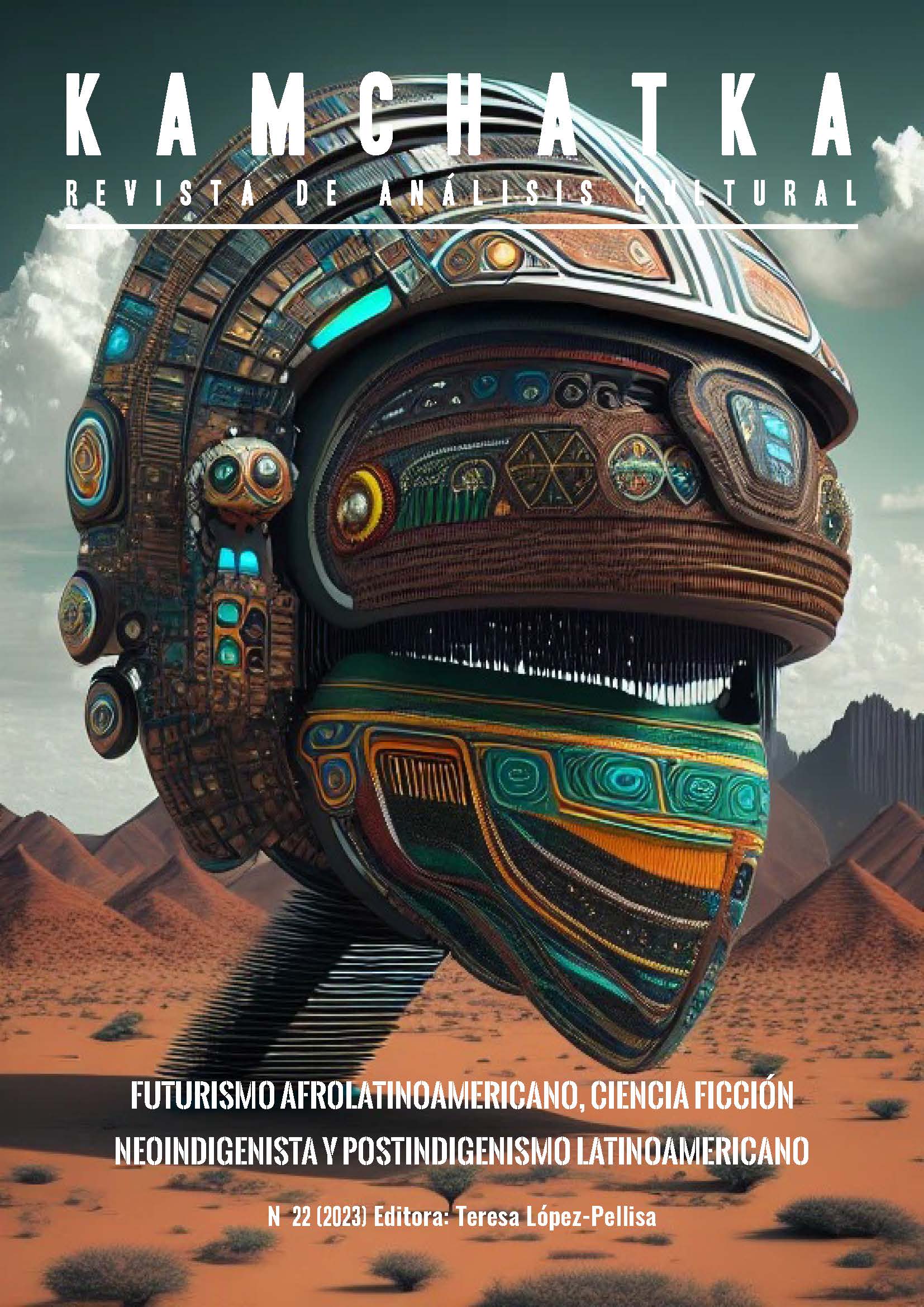Aparapitas from the future: Miguel Esquirol’s Andean science fiction
DOI:
https://doi.org/10.7203/KAM.22.25487Keywords:
Bolivian science fiction, Andean cyborgs, Cyberpunk, Indigenous futurism, Posthumanism, Miguel Esquirol, Jaime Saenz Abstract
Abstract
In 2008, Bolivian writer Miguel Esquirol published the novella “El Cementerio de Elefantes,” a science fiction re-writing of the aparapita’s figure, the Aymara peasant who carries heavy loads on his shoulders in the Bolivian street markets. The aparapita, an emblematic character of La Paz, became —thanks to the literary work of Jaime Saenz— the symbol of the indigenous identity that survives in the city in spite of the modernizing dreams of the nation. Esquirol places the aparapita in a popular market where male workers seek illegal chemical injections to enhance their muscles and prosthesis that make them more competitive; the story explores the body’s connection to the economy —capitalistic but highly illegal and informal— through multiple implants, prosthesis, and chemical substances. The aparapita is both a specter haunting the country and a cornerstone of a national identity crisscrossed by technological and globalizing desires.
In Esquirol’s Andean cyberpunk world, the indigenous body is the place where the city is articulated, where national identity is redefined and where it shows its “abigarrado” (motley) nature, one in which tradition and modernity, past and present, rural and urban life, Indigenous and western cosmovision, high and popular culture overlap in fascinating and unexpected ways.
 Downloads
Downloads
 References
References
Antezana, Luis H (2007). “Afterword.” The Night. Jaime Saenz. Tr. Forrest Gander and Kent Johnson. New Jersey: Princeton UP.
Barragán, Rossana. “Más allá de lo mestizo, más allá de lo aymara: organización y representaciones de clase y etnicidad en La Paz”. América Latina Hoy, 43 (2006): 107-130.
Brown, Andrew J (2010). Cyborgs in Latin America. New York: Palgrave MacMillan.
Canelas, Valeria. “La Paz y el aparapita, textos de Jaime Saenz sobre una ciudad ambivalente”. Ángulo Recto. Revista de estudios sobre la ciudad como espacio plural, 6.1 (2014): 111-124.
Dabove, Juan Pablo (2007). Nightmares of the Lettered City. Banditry and Literature in Latin America 1816-1929. Pittsburgh: University of Pittsburgh Press.
Esquirol Ríos, Miguel (2008). “El Cementerio de Elefantes”. Memorias de futuro. Santa Cruz: La Hoguera: 149-193.
García Linera, Álvaro. “Capitalismo andino-amazónico”. Le Monde Diplomatique: (2016).
Gander, Forrest, and Kent Johnson (2007). “Notes from Bolivia.” Saenz, Jaime. The Night. New Jersey: Princeton UP: 1-27.
Haraway, Donna (2000). “A Cyborg Manifesto.” Bell, David, y Kennedy, Barbara (eds.). The Cybercultures Reader. (eds). London & New York: Routledge: 2091-324.
Laguna, Andrés. “No siempre hay un mañana mejor”. Ciencia Ficción y Fantasía en Bolivia (2009).
Lazar, Sian (2008). El Alto, Rebel City. Self and Citizenship in Andean Bolivia. Durham and London: Duke University Press.
Preciado, Paul B. (2008). Testo yonqui. Barcelona: Espasa.
Saenz, Jaime (1979). Imágenes paceñas: lugares y personajes de la ciudad. La Paz: Difusión.
Saenz, Jaime (1979). Felipe Delgado. La Paz: Difusión.
Saenz, Jaime (2008). Prosa breve. La Paz: Plural
Soto Mejía, María Irina. “‘Almha la vengadora’: Protagonista del indigenismo de neovanguardia alteño”. Bolivian Studies Journal/ Revista de Estudios Bolivianos. Vol 21 (2015): 235-156.
Soto Mejía, María Irina. “El degollador como denuncia y resistencia a la violencia de la necropolítica en los Andes”. Colanzi, Liliana y Castillo, Debra (eds.). Regiones inquietantes: Literatura de horror en Latinoamérica. Hispanic Issues Online (2023). En preparación.
Tapia Mallea, Luis (2002). La producción del conocimiento local: Historia y política en la obra de René Zavaleta. La Paz: Muela del Diablo.
Valencia, Sayak (2016). Capitalismo gore. Control económico, violencia y narcopoder. Ciudad de México: Paidós.
Viscarra, Víctor Hugo (2002). Borracho estaba pero me acuerdo. La Paz: Correveydile.
Zavaleta, René (2009). La autodeterminación de las masas. Bogotá: Siglo del Hombre Editores y Clacso.
Downloads
Published
How to Cite
-
Abstract880
-
Artículo PDF (Español)493
Issue
Section
License
This journal provides an immediate free access to the content on the principle that freely make investigation available to the public, which promotes an increased global knowledge exchange.
Unless otherwise indicated, texts published in this journal are under the license Attribution-NonComercial 4.0 by Creative Commons. These texts may be copied, distributed and publicly communicated whenever the publication’s author and title are quoted and whenever they are not used for commercial purposes. In any case, intellectual property of the articles and its potential economic rights entirely belong to its authors.
The full license can be consulted on https://creativecommons.org/licenses/by-nc/4.0/. We encourage authors to disseminate papers published in Kamchatka. Journal of cultural analysis electronically, in institutional digital repository or in their websites.





